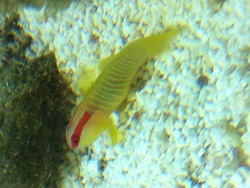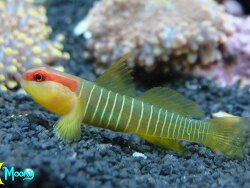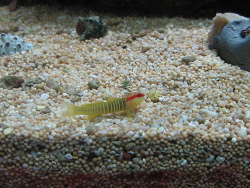Info
Tigrigobius multifasciatus, Steindachner, 1876
Rarely introduced pretty little goby from the Caribbean! Lives a lot on the substrate and spends a lot of time on the decoration.
Like almost all gobies of this genus, this one has no real swim bladder!
It comes out of hiding in a flash when it spots food and disappears into its hiding place just as quickly. If there are no large fish in the aquarium, the gobies will be on the move a lot.
The jerky swimming, or rather the feeling its way forward, is also typical. After every little hop, the goby inspects its surroundings,
to avoid becoming the food of another fish.
Rather something for delicate tanks with fish that are not too large.
Sex
Male gobies can be recognized by their first elongated dorsal fin ray.
The sex of the Elacatinus species is already determined after the fish larva hatches (gonochoristic) and cannot be changed.
Breeding information
The male guards the attached eggs in the cave.
We would be pleased to receive more information here on the number of larvae** and spawning intervals* as this is very important for prospective breeders.
* The water temperature influences the number of fertilized eggs and the spawning period (with a difference of e.g. 1° C, the difference can be ± 2-3 days) and, in the case of gonochoristic (separate-sex) fish or shrimp, the sex. If the temperature is below the usual regional temperature, mainly female larvae will hatch from the clutch, above this temperature mainly male larvae will hatch. Furthermore, the aquarium conditions (e.g. light duration, density) can also influence the sex.
** The spawning size or the number of larvae depends on several factors - age and condition of the parent animals, water conditions, food quality, stress factors and the dissolved oxygen content.
Similar species:
Tigrigobius harvey, Victor, 2014
Tigrigobius rubrigenis, Victor 2014
Synonyms:
Elacatinus multifasciatum (Steindachner, 1876) · unaccepted
Elacatinus multifasciatus (Steindachner, 1876) · unaccepted (synonym)
Gobiosoma multifasciatum Steindachner, 1876 · unaccepted (original combination)
Gobius lineatus Poey, 1861 · unaccepted (synonym)
Jumping guard
A jumping guard prevents (nocturnal) fish from jumping out.
Wrasses, blennies, hawkfishs and gobies jump out of an unprotected tank in fright if their night rest is disturbed, unfortunately these jumpers are found dried up in the morning on carpets, glass edges or later behind the tank.
https://www.korallenriff.de/en/article/1925_5_Jump_Protection_Solutions_for_Fish_in_the_Aquarium__5_Net_Covers.html
A small night light also helps, as it provides the fish with a means of orientation in the dark!
Rarely introduced pretty little goby from the Caribbean! Lives a lot on the substrate and spends a lot of time on the decoration.
Like almost all gobies of this genus, this one has no real swim bladder!
It comes out of hiding in a flash when it spots food and disappears into its hiding place just as quickly. If there are no large fish in the aquarium, the gobies will be on the move a lot.
The jerky swimming, or rather the feeling its way forward, is also typical. After every little hop, the goby inspects its surroundings,
to avoid becoming the food of another fish.
Rather something for delicate tanks with fish that are not too large.
Sex
Male gobies can be recognized by their first elongated dorsal fin ray.
The sex of the Elacatinus species is already determined after the fish larva hatches (gonochoristic) and cannot be changed.
Breeding information
The male guards the attached eggs in the cave.
We would be pleased to receive more information here on the number of larvae** and spawning intervals* as this is very important for prospective breeders.
* The water temperature influences the number of fertilized eggs and the spawning period (with a difference of e.g. 1° C, the difference can be ± 2-3 days) and, in the case of gonochoristic (separate-sex) fish or shrimp, the sex. If the temperature is below the usual regional temperature, mainly female larvae will hatch from the clutch, above this temperature mainly male larvae will hatch. Furthermore, the aquarium conditions (e.g. light duration, density) can also influence the sex.
** The spawning size or the number of larvae depends on several factors - age and condition of the parent animals, water conditions, food quality, stress factors and the dissolved oxygen content.
Similar species:
Tigrigobius harvey, Victor, 2014
Tigrigobius rubrigenis, Victor 2014
Synonyms:
Elacatinus multifasciatum (Steindachner, 1876) · unaccepted
Elacatinus multifasciatus (Steindachner, 1876) · unaccepted (synonym)
Gobiosoma multifasciatum Steindachner, 1876 · unaccepted (original combination)
Gobius lineatus Poey, 1861 · unaccepted (synonym)
Jumping guard
A jumping guard prevents (nocturnal) fish from jumping out.
Wrasses, blennies, hawkfishs and gobies jump out of an unprotected tank in fright if their night rest is disturbed, unfortunately these jumpers are found dried up in the morning on carpets, glass edges or later behind the tank.
https://www.korallenriff.de/en/article/1925_5_Jump_Protection_Solutions_for_Fish_in_the_Aquarium__5_Net_Covers.html
A small night light also helps, as it provides the fish with a means of orientation in the dark!







 robertbaur
robertbaur






















